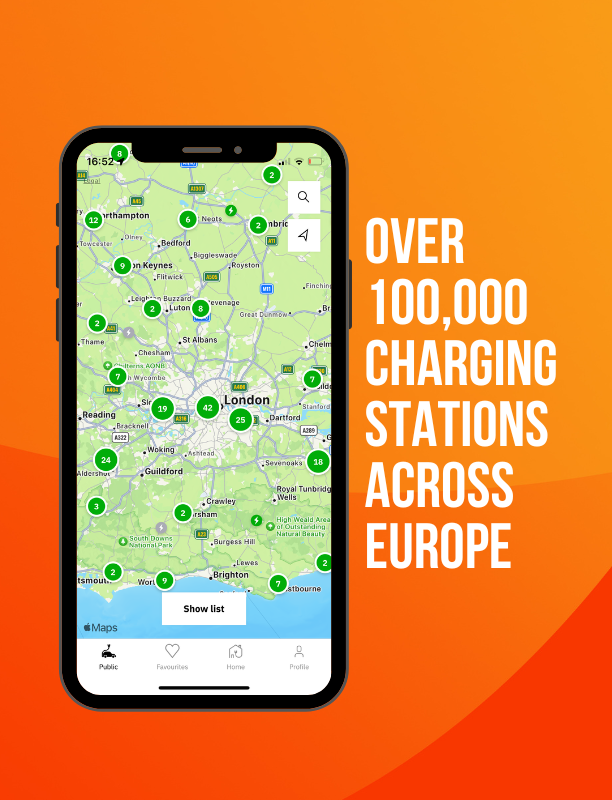Explore Southern Europe's Secret EV Paradise
Escape the tourist crowds and discover breathtaking routes through Spain, Italy, Croatia, France, and Slovenia. From whitewashed mountain villages and UNESCO baroque towns to pristine beaches and alpine-to-Mediterranean transitions, these six carefully curated journeys showcase the authentic cultural and natural wonders of the Mediterranean region while providing practical EV-specific advice, charging solutions, and seasonal considerations for the conscientious traveller.
As electric vehicle infrastructure expands across Southern Europe, a new opportunity emerges for adventurous EV drivers: discovering breathtaking scenic routes and lesser-known attractions beyond mass tourism. This spring, escape the crowds and let your electric vehicle take you through a different side of the Mediterranean region—one of hidden coastal drives, forgotten medieval villages, and pristine natural landscapes where charging is increasingly accessible.
Southern Europe offers electric vehicle enthusiasts unique opportunities to explore beyond typical tourist hotspots. With the expanding charging network and the impressive range of modern EVs, these once challenging regions have become perfect destinations for sustainable exploration. The easyCharging app provides access to over 100,000 charging points across Europe, making it simpler to plan journeys through these less-frequented regions.
 Júzcar, Spain
Júzcar, Spain
Spain: The Forgotten Sierra Route: Andalusia’s White Villages Circuit
This spectacular drive through the Sierra de Grazalema and Sierra Nevada offers EV drivers a remarkable alternative to Spain’s busy coastal roads. The route connects whitewashed mountain villages like Zahara de la Sierra and Grazalema through winding roads with minimal traffic.
The term “Forgotten Sierra Route” comes from how these magnificent mountain ranges have been overlooked by mass tourism despite their extraordinary beauty and cultural significance. The Sierra de Grazalema, Spain’s first UNESCO Biosphere Reserve, receives the highest rainfall in southern Spain, creating a unique microclimate that supports rare flora like the Spanish fir (pinsapo), found nowhere else in Europe. This lush mountain range contrasts dramatically with Andalusia’s typically arid landscape, offering winding roads through dense Mediterranean forests and dramatic limestone formations.
Further east, the mighty Sierra Nevada boasts the Iberian Peninsula’s highest peaks, including Mulhacén (3,479m), which remains snow-capped well into spring. What makes this mountain range particularly fascinating for EV drivers is its remarkable elevation profile—from subtropical coastal areas to alpine environments in just 50 kilometers as the crow flies. The range has been historically isolated due to its challenging terrain, allowing unique cultural traditions to develop in its villages, including distinctive architectural styles, cuisine, and crafts with Moorish influences preserved since the medieval period.
Between these two magnificent mountain ranges lies a network of lesser-known roads connecting pueblos blancos (white villages) that seem frozen in time, offering an authentic glimpse into rural Spanish life rarely experienced by visitors who stick to the coastal resorts.
EV Advantage: Charging infrastructure has been expanding in this region, with several mountain villages now offering charging facilities that allow drivers to top up while enjoying local cuisine. The easyCharging app lets you find fast and reliable charging points with filters for speed and availability, making it easy to locate stations along this scenic route.
Regional Driving Consideration: The significant elevation changes in the Sierra Nevada affect your EV’s range in both ways—uphill climbs can reduce range by 30-40%, but regenerative braking on descents can recover up to 20% of your battery capacity. Plan your charging stops accordingly, particularly before ascending the steeper sections towards Trevélez, Spain’s highest village.
Hidden Gems: Visit the blue-hued village of Júzcar, originally painted for a Smurfs movie promotion but kept blue by local vote. The nearby Cueva del Gato (Cat’s Cave) offers a secluded natural pool experience far from the tourist crowds.
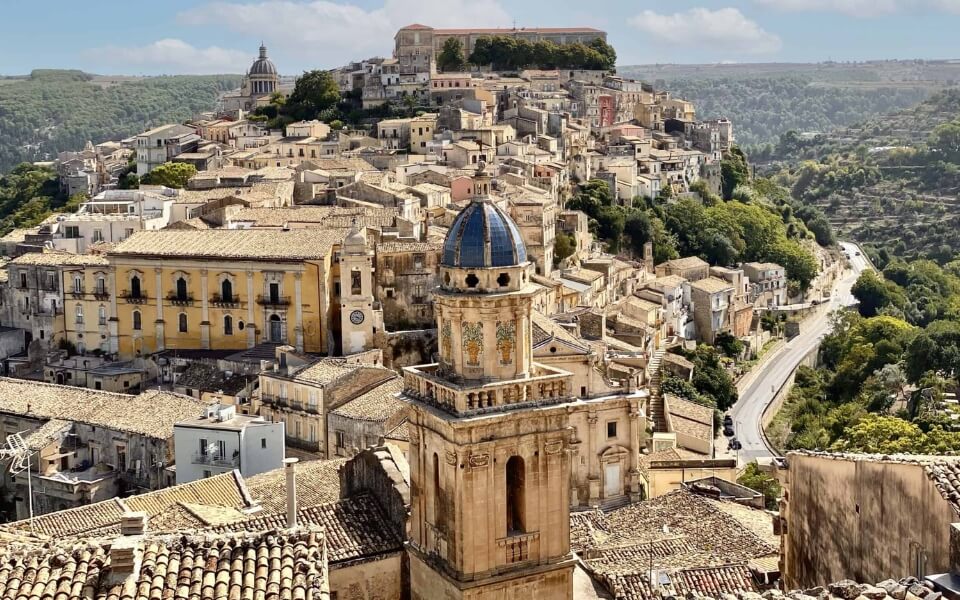 Ragusa Ibla, Sicily
Ragusa Ibla, Sicily
Italy (Sicily): The Baroque Valley Circuit: UNESCO Heritage Without the Crowds
This inland route connects the UNESCO-protected baroque towns of Noto, Modica, and Ragusa through scenic countryside roads rarely featured in guidebooks.
In Noto, often called the “stone garden,” don’t miss the breathtaking Cattedrale di San Nicolò, whose honey-coloured limestone façade glows golden in the late afternoon sun. The elaborate Palazzo Nicolaci with its fantastical balconies supported by grotesque figures and mythological creatures showcases the whimsical side of Sicilian baroque. Pause at the Caffè Sicilia, a historic pasticceria where the almond granita recipe has remained unchanged for generations.
Modica, built across two dramatic gorges, offers a different baroque experience with its dramatic setting. The magnificent Duomo di San Giorgio sits atop 250 steps and features one of Sicily’s most impressive baroque façades. Chocolate lovers shouldn’t miss the town’s celebrated chocolate shops where traditional cioccolato di Modica is still produced using ancient Aztec methods introduced by Spanish colonizers, with no added fats beyond the cocoa butter. The grainy texture and rich flavours (often infused with chili, sea salt, or citrus) make for a unique culinary souvenir.
Ragusa Ibla, the ancient heart of Ragusa, seems to defy gravity as it cascades down a limestone ridge. The stunning Duomo di San Giorgio (distinct from Modica’s cathedral of the same name) sits atop a magnificent staircase in the middle of a picturesque piazza. For a truly immersive experience, wander the labyrinthine medieval streets of the Ibla district at sunset when the baroque buildings take on a rose-gold hue. The Giardino Ibleo, public gardens perched at the town’s edge, offers spectacular views across the surrounding valley.
What makes these three towns exceptional is not just individual monuments but the coherent baroque urban planning—entire cityscapes rebuilt after a devastating 1693 earthquake in the late baroque style, creating a harmonious architectural ensemble that has earned UNESCO World Heritage status as prime examples of “the culmination and final flowering of Baroque art in Europe.”
EV Advantage: Sicily has made significant progress in rural electrification, with charging points now available at agriturismi (farm stays) throughout the region. With easyCharging’s convenient “search-find-pay” functionality, you can easily locate chargers in these baroque towns and countryside locations, with transparent pricing displayed directly in the app.
Regional Driving Consideration: Sicily’s interior features numerous narrow roads with steep gradients, particularly around Monte Iblei. When navigating these areas, using ‘B’ mode or your EV’s strongest regenerative braking setting helps manage both battery consumption and brake wear on the frequent downhill sections.
Wildlife Bonus: The route passes near the Vendicari Nature Reserve, one of Europe’s most important migratory bird sanctuaries. Spring visits offer opportunities to spot flamingos, herons, and various raptors in wetlands that remain largely undiscovered by international tourists.
 Apoxyomenos Museum, Croatia
Apoxyomenos Museum, Croatia
Croatia: Northern Dalmatian Island Chain: EV-Friendly Island Exploration
The islands of Pag, Rab, and the lesser-visited Lošinj are connected by regular car ferries that now accommodate EVs, with charging facilities available at most ferry terminals.
EV Advantage: Croatia’s island authorities have embraced sustainable tourism, installing charging points at key viewpoints that allow you to power up while enjoying panoramic Adriatic vistas. Using the easyCharging app, you can easily find these stations, check their availability in real-time, and mark your favourites for easy access during your island-hopping adventure.
Regional Driving Consideration: When island-hopping with an EV in Croatia, battery management requires forward planning. Ferry waiting times can be significant during peak periods around Zadar and Split, so having access to easyCharging’s network of compatible stations ensures you can charge quickly and conveniently regardless of your vehicle make.
Hidden Attraction: Visit the Apoxyomenos Museum on Lošinj, housing a perfectly preserved ancient Greek bronze statue discovered underwater—a world-class attraction that remains uncrowded even in high season.
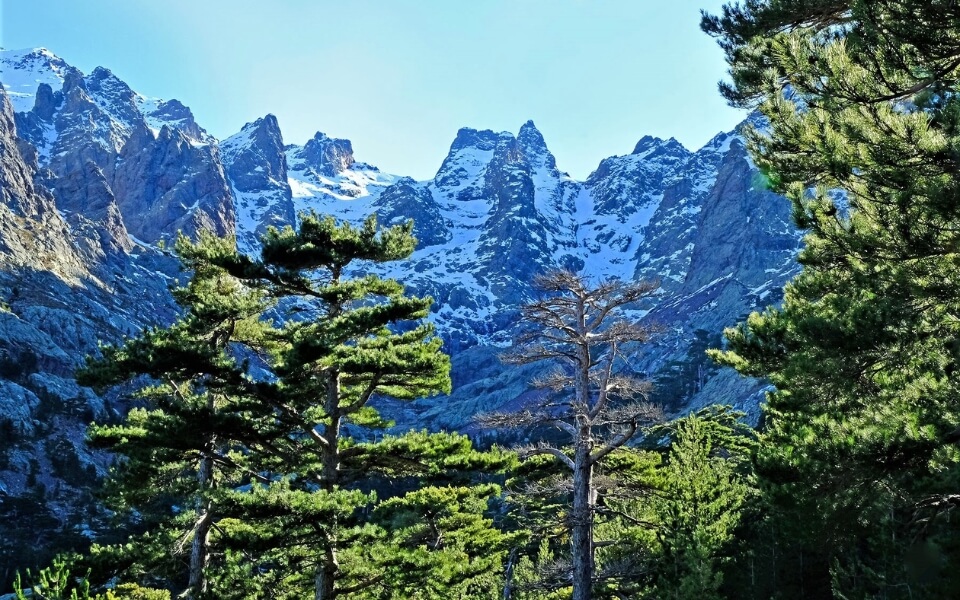 Monte Cinto, Corsica
Monte Cinto, Corsica
France (Corsica): The Haute-Corse Mountain Route: Engineering Marvel Meets Natural Wonder
This challenging but rewarding circuit takes drivers through the island’s mountainous backbone, including the Col de Bavella and the spectacular Restonica Valley.
The “Engineering Marvel” aspect of this route refers to the remarkable D84 and D81 roads that traverse Corsica’s intimidating mountainous terrain. Carved into sheer cliff faces during the 19th and early 20th centuries, these engineering feats remain some of Europe’s most dramatic driving routes. The Scala di Santa Regina, a narrow gorge section of the D84, features tunnels bored through solid granite and bridges spanning dizzying drops, all constructed with limited machinery before modern road-building techniques existed. These roads were historically vital for connecting isolated mountain communities and represent a triumph of human determination over some of the Mediterranean’s most challenging topography.
The “Natural Wonder” component stems from the road’s passage through Corsica’s diverse microclimates and ecosystems. The route traverses the island’s central massif, where weathered granite peaks soar above 2,000 metres. The Col de Bavella (1,218m) presents an otherworldly landscape of wind-eroded pinnacles known as the Aiguilles de Bavella (Bavella Needles), often compared to miniature Dolomites but with distinctive reddish hues. The surrounding Corsican laricio pine forests contain trees over 1,000 years old, with twisted trunks shaped by mountain winds.
In the Restonica Valley, the road follows an ancient glacial valley where crystal-clear pools form between polished granite boulders, creating natural swimming spots of exceptional beauty. The valley culminates at Lac de Melo and Lac de Capitello, two alpine lakes nestled in cirques below Corsica’s highest peaks, accessible via short hiking trails from the road’s end.
EV Advantage: The mountain roads’ frequent switchbacks and elevation changes are ideal for regenerative braking systems. Strategic charging points have been installed at mountain refuges and rural restaurants. With easyCharging’s comprehensive coverage, you can quickly start and stop charging sessions directly within the app, making brief stops more efficient along this demanding route.
Regional Driving Consideration: Corsica’s mountain passes can put significant strain on EV battery range, particularly in the central region around Monte Cinto. During summer months, using climate control adds further drain. Pre-cooling your car while still connected to a charger before tackling the highest passes can preserve valuable range.
Unique Experience: Stop at the ancient chestnut forests of the Castagniccia region, where traditional harvest methods are still used, and local producers offer tastings of chestnut-based delicacies rarely found elsewhere.
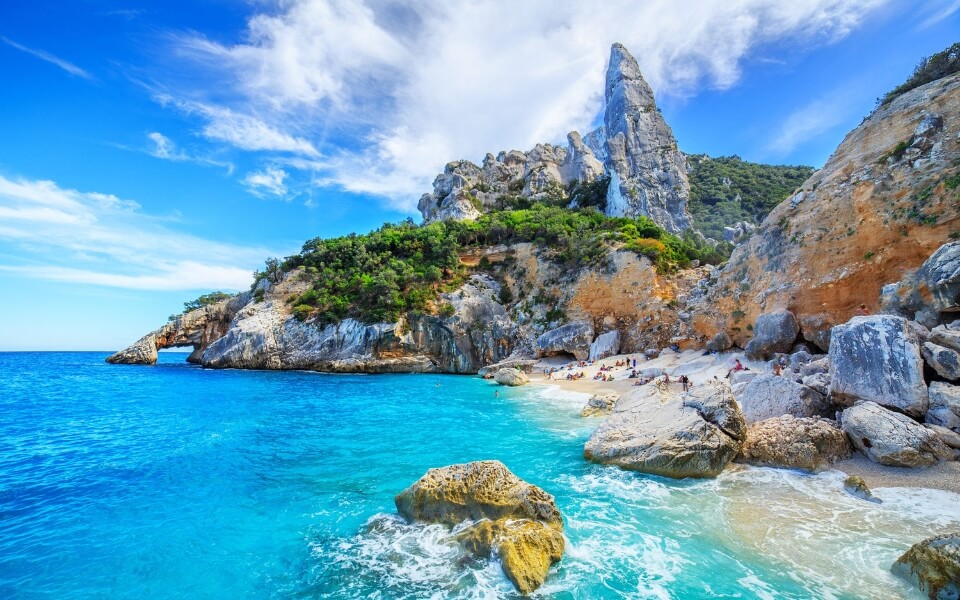 Cala Goloritzé, Sardinia
Cala Goloritzé, Sardinia
Italy (Sardinia): The Ogliastra Coastal Discovery: Beaches Without Footprints
This route traces Sardinia’s eastern shoreline, connecting hidden coves and beaches accessible only by narrow coastal roads or short hikes from Baunei to Tortolì.
Ogliastra remains Sardinia’s least developed coastal region, often referred to as the island’s “wild east.” Unlike the glitzy Costa Smeralda in the north or the more accessible southern beaches, this rugged stretch of coastline features dramatic limestone cliffs plunging directly into turquoise waters, creating a series of secluded coves that rank among the Mediterranean’s most pristine.
The jewel of this coastline is Cala Goloritzé, a beach of almost surreal beauty featuring a striking 143-metre limestone pinnacle and natural arch that frames its crystal-clear waters. Created by a landslide in 1962, this relatively “new” beach is accessible only by boat or a challenging 90-minute hike from the Golgo plateau above Baunei, ensuring limited visitor numbers. The Italian government declared it a “National Monument” in 1995, implementing strict protection measures that prohibit motorized vessels within 300 metres of the shore.
Further north, the Selvaggio Blu (Wild Blue) trail connects several hidden beaches like Cala Mariolu, Cala dei Gabbiani, and Cala Biriola. Each features distinctive characteristics—from fine pebbles that create jewel-like water colours to unusual rock formations and sea caves. These beaches remain uncrowded even in peak season due to their limited accessibility.
For EV drivers, this region offers a unique advantage. The main coastal road, the SS125 Orientale Sarda, was recently modernized with several panoramic sections featuring lay-bys where drivers can stop and admire breathtaking vistas. These improvements included charging infrastructure at strategic points, making what was once a challenging region for electric vehicles now perfectly navigable, while still preserving the wild character that makes Ogliastra special.
EV Advantage: New charging infrastructure funded by sustainable tourism initiatives ensures that even remote areas are accessible to electric vehicles. Coastal towns like Tortolì, Baunei, and Cala Gonone have installed charging points, and with easyCharging’s compatibility with plugs for all major car manufacturers, you can charge reliably regardless of what EV you’re driving.
Regional Driving Consideration: Sardinia’s eastern coastal roads feature frequent steep sections and limited passing opportunities. EVs excel in these conditions compared to traditional vehicles, as their instant torque makes overtaking safer when opportunities arise, particularly on the winding roads between Santa Maria Navarrese and Cala Gonone.
Kayaking Highlight: The limestone cliffs near Baunei conceal sea caves and secluded beaches inaccessible by road. Local operators offer guided electric boat or kayak tours that complement your low-impact EV journey.
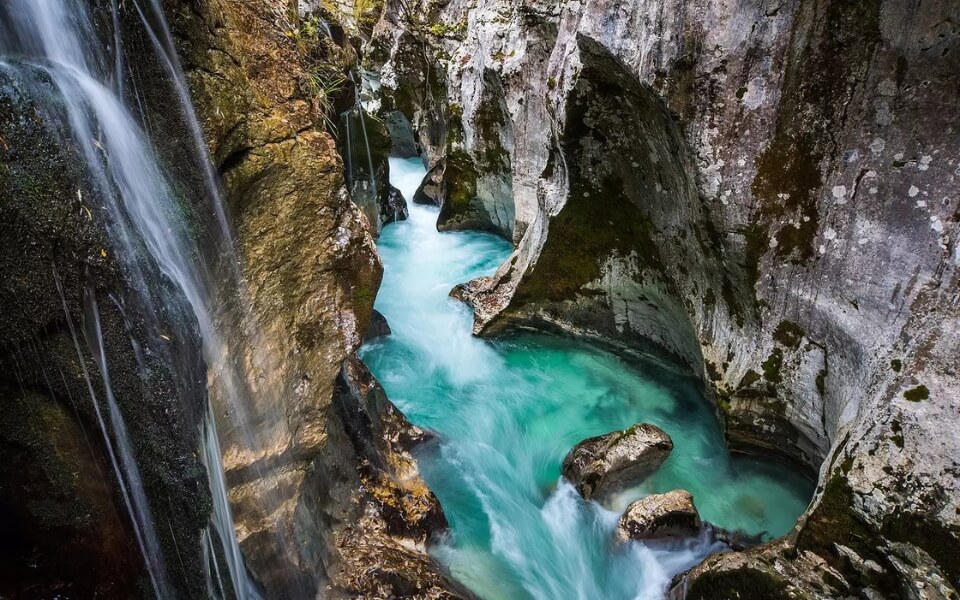 Velika Korita, Slovenia
Velika Korita, Slovenia
Slovenia: The Emerald River Valley: Alpine-to-Mediterranean in Hours
This route follows the stunning Soča River from its Alpine source down to the Mediterranean-influenced Goriška Brda wine region.
The Soča (pronounced “So-cha”) earns its “Emerald River” nickname from its extraordinary turquoise-green waters—a colour so distinctive it seems almost artificially enhanced. This unique hue results from the river’s limestone bedrock and mineral content, creating what many consider Europe’s most beautiful river. The Soča’s pristine waters flow for about 138 kilometres from its source in the Trenta Valley near the Italian border through Slovenia’s northwestern corner before entering Italy (where it’s known as the Isonzo).
What makes this river valley route remarkable is the astonishing ecological and cultural diversity experienced in such a compressed geographic space. Your journey begins in the high Alpine environment near Kranjska Gora, where snow-capped peaks of the Julian Alps dominate the landscape and traditional Alpine architecture features wooden chalets with steep roofs designed to shed heavy snow. Within just 60 kilometres, you’ll descend through dense spruce and beech forests into a warmer climate zone where Mediterranean influences become increasingly evident.
The river itself transforms along this journey, starting as a narrow, tumbling mountain stream before widening into a powerful watercourse that has carved impressive gorges like the Velika Korita (Great Gorge) with its 15-metre-high walls. The Kozjak Waterfall, accessible via a wooden pathway through a natural rock tunnel, represents another highlight where the river’s tributary drops dramatically into an emerald pool within a moss-covered amphitheatre of stone.
As you continue downstream, the valley broadens and the landscape transforms. The architecture shifts from Alpine to distinctly Venetian-influenced styles with stone houses featuring red-tiled roofs. The flora changes dramatically too—grape vines, olive groves, and even fig trees appear as you approach the Goriška Brda wine country, often called “Slovenia’s Tuscany.”
This region’s wine tradition dates back to Roman times but received significant influence from the Republic of Venice during its 400-year presence. Today, local winemakers produce excellent whites from indigenous varieties like Rebula (Ribolla Gialla) and international grapes including Chardonnay and Sauvignon Blanc. Many vineyards offer tastings with magnificent views across rolling hills dotted with cypress trees and church steeples—a landscape that would not look out of place in central Italy.
For EV drivers, this route offers a fascinating opportunity to experience how regenerative braking systems perform across varied terrain. The initial descent from the Julian Alps can add significant range to your battery through energy recovery, while the gentler undulations of the wine country provide an ideal balance between power consumption and regeneration. The relatively short distances involved—you can drive from Alpine meadows to Mediterranean vineyards in under two hours—make this route perfectly suited to electric vehicles of all ranges.
EV Advantage: Slovenia has one of Europe’s best-developed rural charging networks, with stations even in remote Alpine villages. The country’s compact size makes range anxiety virtually non-existent. With easyCharging’s detailed charging history feature, you can track your energy consumption patterns as you traverse from Alpine to Mediterranean climates, helping you plan future trips more efficiently.
Regional Driving Consideration: The dramatic elevation changes from the Julian Alps down to the Mediterranean-influenced valleys can significantly affect EV range. However, this route is particularly well-suited to electric vehicles, as the long descents from Vršič Pass (Slovenia’s highest road) provide extensive regenerative braking opportunities—potentially adding 50+ kilometres of range during descent.
Historical Discovery: Visit the restored WWI trenches at Kobarid, where Ernest Hemingway found inspiration for “A Farewell to Arms,” then continue to family-run vineyards in Brda that rarely appear on wine tourism circuits.
Essential EV Travel Tips for Southern European Hidden Routes
-
Download the easyCharging App: With access to over 100,000 charging points across Europe, easyCharging provides comprehensive coverage throughout Southern Europe. The all-in-one app lets you search, find, and pay for charging all in one place, with no contracts or extra fees.
-
Get Your Free RFID Card: easyCharging offers a free RFID card for charging without needing to use the app, which can be particularly useful in areas with limited mobile reception.
-
Learn Basic Charging Vocabulary: Phrases like “Can I charge my car?” in Spanish (¿Puedo cargar mi coche?), Italian (Posso ricaricare la mia auto?), Croatian (Mogu li napuniti svoj automobil?), and French for Corsica (Puis-je recharger ma voiture?) will prove invaluable in rural areas.
-
Carry an Emergency Charging Cable: For truly remote areas, a portable EVSE that can connect to standard outlets (with appropriate adapters for Southern European sockets) may extend your reach beyond the established charging network.
-
Benefit from 24/7 Support: easyCharging’s round-the-clock customer support provides peace of mind when travelling through remote regions, ensuring help is available whenever you need it.
Best Times to Visit
The optimal times to explore these hidden routes are April through June or September through October, when weather conditions are ideal and roads are less busy. Many of these regions offer springtime festivals celebrating local harvests and traditions that remain authentically local rather than tourist-oriented performances.
Seasonal Considerations for EV Performance:
- Spring (April-June): Moderate temperatures mean minimal climate control usage, maximising your EV’s range. However, be prepared for occasional charging delays around Easter holidays, particularly in religious regions like Sicily and rural Spain.
- Autumn (September-October): Ideal battery operating temperatures and reduced tourism pressure on charging infrastructure. The grape harvest in regions like Goriška Brda and Castagniccia adds cultural interest to your journey.
- Summer (July-August): Higher temperatures can affect battery efficiency and charging speeds. If travelling during this period, plan charging stops for early morning or evening when temperatures are lower, particularly in southern regions like Andalusia and Sicily.
Remember that travelling these lesser-known routes isn’t just about reducing your carbon footprint—it’s about distributing tourism euros to communities that rarely benefit from mainstream tourism, while enjoying authentic experiences that mass tourism hasn’t altered.
Your electric vehicle isn’t just transportation on these journeys—it’s your key to accessing a different, more authentic Southern Europe that still exists beyond the crowded resorts and tour bus stops. With easyCharging’s extensive network coverage and user-friendly interface, you can charge quickly, conveniently, and reliably anywhere along these routes, receiving detailed monthly statements of your charging history while enjoying transparent pricing throughout your journey.
By choosing electric vehicle exploration of these lesser-known routes, you’re participating in the quiet revolution of sustainable tourism—experiencing the authentic cultural and natural wonders of Southern Europe whilst contributing to its environmental preservation.

